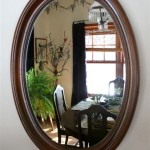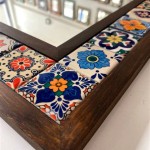Removing a Bathroom Mirror from the Wall: A Comprehensive Guide
Removing a bathroom mirror from the wall is a common home improvement task, often undertaken during renovations, repairs, or when simply updating the décor. While the process might seem straightforward, it requires careful planning, the right tools, and a methodical approach to minimize the risk of damage to the mirror, the wall, and, most importantly, yourself. This article provides a detailed guide to removing a bathroom mirror safely and effectively.
Before commencing any removal process, a thorough assessment of the mirror's installation is crucial. Mirrors are commonly affixed to walls using one of several methods: adhesive (mirror mastic), clips, or a combination of both. Identifying the attachment method dictates the necessary tools and techniques. A misidentified attachment method can lead to broken glass or significant drywall damage.
Gathering the appropriate tools and safety equipment is the next vital step. The necessary equipment typically includes: safety glasses, work gloves, a putty knife or thin pry bar, a utility knife, a heat gun or hair dryer (optional), painter's tape, a level, a stud finder (optional), masking tape, and a container for disposal of broken glass fragments. Having these readily available streamlines the process and reduces the risk of injury or property damage.
Safety is paramount throughout this project. Mirrors, by their nature, are fragile and can shatter into sharp fragments. Always wear safety glasses and work gloves to protect your eyes and hands from potential injury. Working slowly and deliberately prevents accidents. Furthermore, protecting the surrounding surfaces with drop cloths or cardboard minimizes the risk of damage from falling debris or accidental tool slips.
Key Point 1: Assessing the Mirror's Attachment Method
The first step in removing a bathroom mirror is to accurately identify how it is attached to the wall. This seemingly simple step is crucial for a successful and damage-free removal. Mirrors are generally attached using one of three primary methods: adhesive (often referred to as mirror mastic), mechanical fasteners such as clips or screws, or a combination of both. Determining which method is employed will dictate the necessary tools and techniques.
To determine if the mirror is attached with adhesive, carefully examine the edges of the mirror where it meets the wall. Look for signs of caulk or a bead of dried adhesive. Run a thin, flexible blade, such as a putty knife or a utility knife, along the edge of the mirror. If the blade encounters resistance, it is likely that the mirror is adhered to the wall. The presence of caulk does not automatically indicate adhesive attachment; caulk is often used to seal the edges and prevent moisture intrusion. However, if caulk is present in conjunction with resistance when attempting to insert a blade, adhesive is likely a primary component of the attachment.
To identify mechanical fasteners, inspect the perimeter of the mirror for visible clips or screws. These clips are typically made of metal or plastic and may be partially concealed by the mirror's frame or edge. Mirrors attached solely with clips are generally easier to remove than those attached with adhesive. If clips are visible, carefully examine how they are secured. Some clips may simply slide out of place, while others may require unscrewing. Attempting to force a clip without understanding its mechanism can damage the mirror or the wall.
In some cases, both adhesive and mechanical fasteners are used. This combination provides a more secure attachment, making the mirror more difficult to remove. If clips are present but the mirror still feels firmly attached to the wall, adhesive is likely also being used. In such instances, the adhesive will need to be addressed before the clips can be removed effectively.
If visual inspection does not definitively reveal the attachment method, a small exploratory cut can be made at the edge of the mirror with a utility knife. This small cut can reveal the presence of adhesive behind the mirror without causing significant damage. Exercise extreme caution when making this cut to avoid scratching the mirror's surface or cutting yourself.
After determination of the precise attachment method, it is important to fully prepare based on the method employed. For example, if the mirror is secured with adhesive, heat and cutting tools will be useful in the next removal step. If secured with clips, a screw driver and careful movements will be necessary.
Key Point 2: Removing a Mirror Attached with Adhesive
Removing a mirror attached with adhesive requires patience and a systematic approach. Forceful removal can easily lead to the mirror shattering, creating a hazardous situation. The goal is to weaken the adhesive bond gradually, allowing the mirror to be detached safely.
Start by protecting the surrounding area. Cover the floor with a drop cloth or cardboard to catch any falling debris. Apply painter's tape along the edges of the mirror where it meets the wall. This tape helps to prevent damage to the wall paint or wallpaper during the removal process. The tape creates a barrier that protects the wall from scratches and reduces the risk of paint peeling when the mirror is detached.
Next, attempt to loosen the adhesive bond. This can be achieved through the application of heat. Use a heat gun or a hair dryer to warm the adhesive around the perimeter of the mirror. Apply heat in a sweeping motion, avoiding prolonged exposure to any one area. Excessive heat can damage the mirror's backing or the wall surface. The heat softens the adhesive, making it easier to separate the mirror from the wall.
After applying heat, use a putty knife or a thin pry bar to carefully pry the mirror away from the wall. Start at one corner and gently work your way around the perimeter. Insert the putty knife between the mirror and the wall and apply gentle pressure. Avoid using excessive force, as this can cause the mirror to crack. If you encounter significant resistance, apply more heat to the affected area and try again. The key is to work slowly and methodically, gradually separating the mirror from the wall.
If necessary, use a utility knife to cut through the adhesive behind the mirror. Insert the blade between the mirror and the wall and carefully slice through the adhesive. Work slowly and deliberately, avoiding any sudden movements. Be extremely careful not to cut yourself or scratch the mirror's surface. Continue this process until the mirror is completely detached from the wall.
Once the mirror is detached, carefully remove it from the wall and place it on a protected surface. Clean any remaining adhesive from the wall using a scraper or adhesive remover. Follow the manufacturer's instructions for the adhesive remover and always test it in an inconspicuous area first to ensure that it does not damage the wall paint or wallpaper.
Key Point 3: Removing a Mirror Attached with Clips
Removing a mirror attached with clips is typically a simpler process than removing one attached with adhesive. However, it still requires care and attention to avoid damaging the mirror or the wall. The first step is to identify the type of clips being used and how they are secured.
Examine each clip carefully. Some clips are designed to simply slide out of place. These clips typically have a small tab or lever that can be pushed or pulled to release the mirror. Other clips are secured with screws. These screws will need to be removed before the mirror can be detached. Use the appropriate screwdriver to remove the screws, being careful not to strip the screw heads. A magnetized screwdriver can be particularly helpful in preventing screws from falling and becoming lost.
Once the clips are released or the screws are removed, carefully detach the mirror from the wall. Have a helper assist in holding the mirror to prevent it from falling. Gently lift the mirror upwards and outwards, ensuring that it clears all of the clips. If the mirror feels stuck, double-check that all of the clips have been released or removed. Do not force the mirror, as this can damage the clips or the wall.
After the mirror is detached, inspect the wall for any remaining clip hardware. Remove any remaining clips or brackets from the wall. If the clips were attached with screws, fill the screw holes with spackle or drywall compound. Allow the spackle to dry completely and then sand it smooth. Prime and paint the patched areas to match the surrounding wall color.
Occasionally, mirrors are secured with a combination of clips and adhesive. In these cases, the clips should be removed first, following the steps outlined above. Then, address the adhesive using the techniques described in the previous section. The presence of clips might make it easier to gain leverage for the putty knife or pry bar when separating the mirror from the wall.
Finally, whether attached by adhesive, clips, or a combination of both, safe disposal of a mirror is key. Glass shards can be very dangerous with extended dangers if walked on or left at a site where children play. Safe disposal is a critical final step in ensuring the scene is safe.

How To Remove A Bathroom Mirror Lowe S

How To Remove A Mirror Glued The Wall Forbes Home

How To Remove Mirror Off Wallsafely

How To Safely And Easily Remove A Large Bathroom Builder Mirror From The Wall Site Title

How To Safely And Easily Remove A Large Bathroom Builder Mirror From The Wall Site Title

How To Remove A Frameless Mirror Like Nervous Grandma

How To Safely And Easily Remove A Large Bathroom Builder Mirror From The Wall Site Title

How To Remove A Large Mirror That S Glued The Wall Emerging Home

How To Remove A Wall Mirror Diy Weekend Project Bedroom Black

How To Remove A Bathroom Mirror Lowe S








